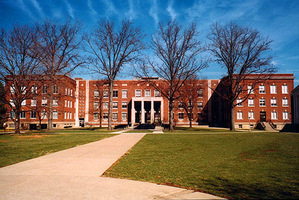 | Back to e-WV
| Back to e-WV
 The West Virginia Encyclopedia
The West Virginia Encyclopedia
 | Back to e-WV
| Back to e-WV
 The West Virginia Encyclopedia
The West Virginia Encyclopedia

On March 30, 1837, the Virginia legislature granted a charter to establish a private academy at West Liberty, north of Wheeling in Ohio County. The first class of 65 children met in the home of the Reverend Nathan Shotwell in 1838. In 1857, public-spirited citizens completed a three-story, red brick Academy Hall, which survived until the mid-1970s.
The school catalog of 1859 described a school year that lasted from early September to late June. Male students studied classical subjects such as Greek, Latin, and philosophy, and females studied such things as literature, writing, and geography. All students attended daily chapel, and public worship on the Sabbath. Students secured lodging in private homes or boarding houses. West Liberty’s first dorms would not be built until 1920.
The Civil War caused enrollment declines, and by 1867, a debt of $6,000 forced the trustees to sell the school to the new state of West Virginia. The legislature passed the ‘‘Act to establish a branch Normal School at West Liberty’’ on March 1, 1870. For the next 61 years, the school was a teacher preparatory institution, and until 1923, also a high school.
The first 50 graduating classes, 1872–1922, totaled only 730 students. There was no physical education department or scholastic athletics before 1921. No activity approached the popularity of the literary societies, the best-known of which were the Bryants and the Irvings, rivals from 1888 to 1925.
The post-World War I period proved unsettling. State education officials, concerned about low enrollments (134 in 1925) and weak community support, suggested moving the campus to a location nearer Wheeling. In the end, the West Liberty defenders convinced the state to permit the school to remain on its hilltop.
In 1926, John S. Bonar, Class of 1913, became president and began to expand the school. His first task was to secure money to erect Curtis and McColloch halls, the west and east wings respectively of today’s Main Hall. They were completed on West Liberty’s new campus, on a 100-acre farm a short distance south of Academy Hall, purchased during the presidency of John Shaw, a predecessor of Bonar. By 1931, the state changed the school name to West Liberty State Teachers College.
During the Great Depression, enrollments fell once more; appropriations shrank; and faculty salaries suffered deep cuts. Then in 1935 Paul N. Elbin, a member of the English faculty since 1928, assumed the presidency, a position he was to hold for 35 years. Elbin exploited the public works programs of the Franklin Roosevelt administration, principally the Public Works Administration and the Works Progress Administration. One grant provided money to build a boys’ dorm, Fraternity (later Shotwell) Hall; another built the first faculty housing project. Other federal funds permitted the college to landscape the campus, improve roads, update sports facilities, paint the interior of its buildings, create a physics department, and install the first student union in West Virginia.
New programs were added in art, music, and home economics. The dental hygiene department opened in 1938 and quickly became one of the college’s most widely respected majors. Also in 1938, a branch campus opened in Wheeling, which in 1972 became West Virginia Northern Community College. In the same momentous year, the college received the unconditional accreditation it has maintained ever since.
In 1943, the state legislature changed the name to West Liberty State College. With World War II under way, enrollments plummeted from 325 in 1939 to 212 in 1942 to only 118 in the fall of 1944. By V-E Day, a mere 100 students remained on the campus, and only eight were men.
The fall of 1945 opened with a class of 225, the largest since 1940. By the spring of 1946, the student newspaper, Trumpet, reported the beginnings of what was to become a welcome avalanche: 52 military veterans attended classes. Ex-servicemen, taking advantage of the GI Bill, soon pushed enrollment figures to record highs. Enrollments leveled off in the early 1950s, then rose again by the mid-decade, as GIs from the Korean conflict took their places in West Liberty classrooms. By 1960, West Liberty’s on-campus enrollment exceeded 1,000 for the first time.
In the 1960s, West Liberty witnessed unprecedented building to accommodate the baby-boom generation. The number of students tripled by 1970. Five new dorms opened, as did the Hall of Fine Arts, Interfaith Chapel, a remodeled and enlarged College Union, and the Paul N. Elbin Library. In 1972 West Liberty lost its Wheeling and Weirton branch campuses, which became West Virginia Northern Community College. Construction at West Liberty has been limited to a science building (Arnett Hall), a dorm (Krise Hall), Bartell Fieldhouse, and a new academic, sports and athletic complex. By the turn of the 21st century, the programs with the largest number of majors were criminal justice, elementary education, and business administration.
On November 21, 2008, the West Virginia Higher Education Policy Commission voted to award university status to West Liberty State College. The West Liberty State College Board of Governors subsequently voted to make the name change effective May 3, 2009. In fall 2022, the school’s enrollment was 2,315.
West Liberty University website
Written by David T. Javersak
Regier, C. C. West Liberty, Yesterday and Today. Wheeling News Litho. Co., 1939.
Reuter, Frank T. West Liberty State College: The First 125 Years. West Liberty State College, 1963.
Javersak, David T. West Liberty State College, 1837-1987. Upper Ohio Valley Historical Review, (Fall-Winter 1987).